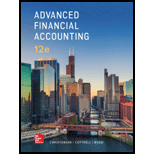
Concept explainers
a
Introduction: The consolidation procedure used in the second year and the subsequent year is similar to that of the first. The equity method is used to evaluate the investment in the subsidiary. In order to determine consolidation entries, the change in the parent’s investment in the second or subsequent year is determined. Any differential arising is recognized and all the intercompany transactions are eliminated.
The equity method entries that P would record for its investment in S during 20X8.
b
Introduction: The consolidation procedure used in the second year and the subsequent year is similar to that of the first. The equity method is used to evaluate the investment in the subsidiary. In order to determine consolidation entries, the change in the parent’s investment in the second or subsequent year is determined. Any differential arising is recognized and all the intercompany transactions are eliminated.
The Consolidation entries needed for December 31, 20X8
Want to see the full answer?
Check out a sample textbook solution
Chapter 5 Solutions
EBK ADVANCED FINANCIAL ACCOUNTING
- Can you demonstrate the proper approach for solving this financial accounting question with valid techniques?arrow_forwardCan you demonstrate the accurate steps for solving this financial accounting problem with valid procedures?arrow_forwardTitan Manufacturing applies overhead cost to jobs on the basis of 85% of direct labor cost. If Job 427 shows $93,500 of manufacturing overhead applied, the direct labor cost on the job was: a. $79,475 b. $110,000 c. $120,000 answer?arrow_forward
- I need help finding the accurate solution to this general accounting problem with valid methods.arrow_forwardPreview Ltd is considering an investment in a new machine for the production of a new product X. There are two possibilities, Machine A and Machine B. Both the product and the machine would have an expected life of five years. The following information is available:Product X Selling price N$50 Variable cost N$32Increase in fixed overhead (excluding depreciation of the new machine) is N$90,000 per year.Sales unitsYear 1 10,000 2 15,000 3 20,000 4 20,000 5 5,000Machine A Machine BInitial cost (N$000) 550 480Residual value (N$000) 50 30The company’s cost of capital is 10%, the appropriate discount factors are:Year 1 0.909Year 2 0.826Year 3 0.751Year 4 0.682Year 5 0.621Required:a) Evaluate each machine, A and B, using the following methods:(i) Accounting rate of return (using average investment) (ii) Payback (iii) Net present valueb) On the basis of your figures in (a) above, advice management as to which machine to purchase, stating reasons for your decision.arrow_forwardI need help finding the accurate solution to this financial accounting problem with valid methods.arrow_forward

 AccountingAccountingISBN:9781337272094Author:WARREN, Carl S., Reeve, James M., Duchac, Jonathan E.Publisher:Cengage Learning,
AccountingAccountingISBN:9781337272094Author:WARREN, Carl S., Reeve, James M., Duchac, Jonathan E.Publisher:Cengage Learning, Accounting Information SystemsAccountingISBN:9781337619202Author:Hall, James A.Publisher:Cengage Learning,
Accounting Information SystemsAccountingISBN:9781337619202Author:Hall, James A.Publisher:Cengage Learning, Horngren's Cost Accounting: A Managerial Emphasis...AccountingISBN:9780134475585Author:Srikant M. Datar, Madhav V. RajanPublisher:PEARSON
Horngren's Cost Accounting: A Managerial Emphasis...AccountingISBN:9780134475585Author:Srikant M. Datar, Madhav V. RajanPublisher:PEARSON Intermediate AccountingAccountingISBN:9781259722660Author:J. David Spiceland, Mark W. Nelson, Wayne M ThomasPublisher:McGraw-Hill Education
Intermediate AccountingAccountingISBN:9781259722660Author:J. David Spiceland, Mark W. Nelson, Wayne M ThomasPublisher:McGraw-Hill Education Financial and Managerial AccountingAccountingISBN:9781259726705Author:John J Wild, Ken W. Shaw, Barbara Chiappetta Fundamental Accounting PrinciplesPublisher:McGraw-Hill Education
Financial and Managerial AccountingAccountingISBN:9781259726705Author:John J Wild, Ken W. Shaw, Barbara Chiappetta Fundamental Accounting PrinciplesPublisher:McGraw-Hill Education





